北回歸線立標
為提供使用者有文書軟體選擇的權利,本文件為ODF開放文件格式,建議您安裝免費開源軟體 ([連結])
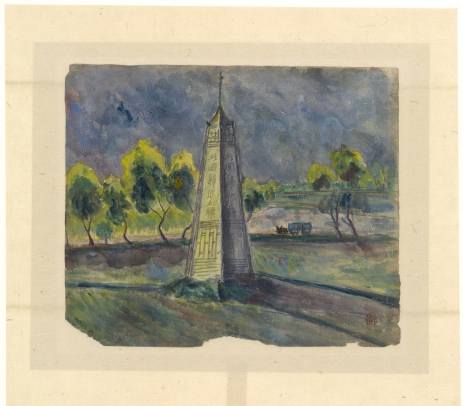
北回歸線立標
Tropic of Cancer Post
北回帰線立標
ca. 1921-1923 紙本水彩, 24×28.5cm.
watercolor on paper
紙本水彩
方錐狀的標誌矗立在縱貫鐵道旁,高聳的紀念性建物象徵著帝國的榮耀,同時也將南國臺灣的特色濃縮為兩行科學化的描述。「北緯二十三度二十七分四秒」,正是這些數字,孕育了福爾摩沙島上豐饒的多樣性。緣此而生的蓊鬱的山,碧藍的海,艷陽下的原野,北回歸線上這座島嶼的萬千風景,都將在陳澄波的畫裡,表現出絕美的顏色。
Towering over the West Coast Rail Line which runs north to south along Taiwan’s west coast, the commemorative obelisk symbolizes the glory of the Japanese Empire and bears inscriptions which condense the uniqueness of its southland territory of Taiwan into two columns of scientific description. It is precisely these numbers, or rather this latitude, 23°27’4” N, which has nurtured the diverse landscapes of Formosa. The lush mountain forests, deep blue waters, and open fields illuminated by the bright sun—all the myriad landscapes of this island lying along the Tropic of Cancer—are represented in exquisite color in Chen Cheng-po’s artwork.
縦貫鉄道の傍らに立つ方錐形の標塔。高々とそびえる記念碑は国家の繁栄を象徴すると同時に、南国台湾の特色がわずか2行の科学的な数値へと濃縮されています。
「北緯23度27分4秒」。この数値の下でフォルモサ(麗しの島)といわれる台湾の豊かな多様性が育まれてきたのです。そうして生まれた、樹木茂る山々や紺碧の海、明るい日差しが降り注ぐ原野─陳澄波の絵画には北回帰線上に位置するこの島の、ありとあらゆる風景が無上の色彩美で表現されています。
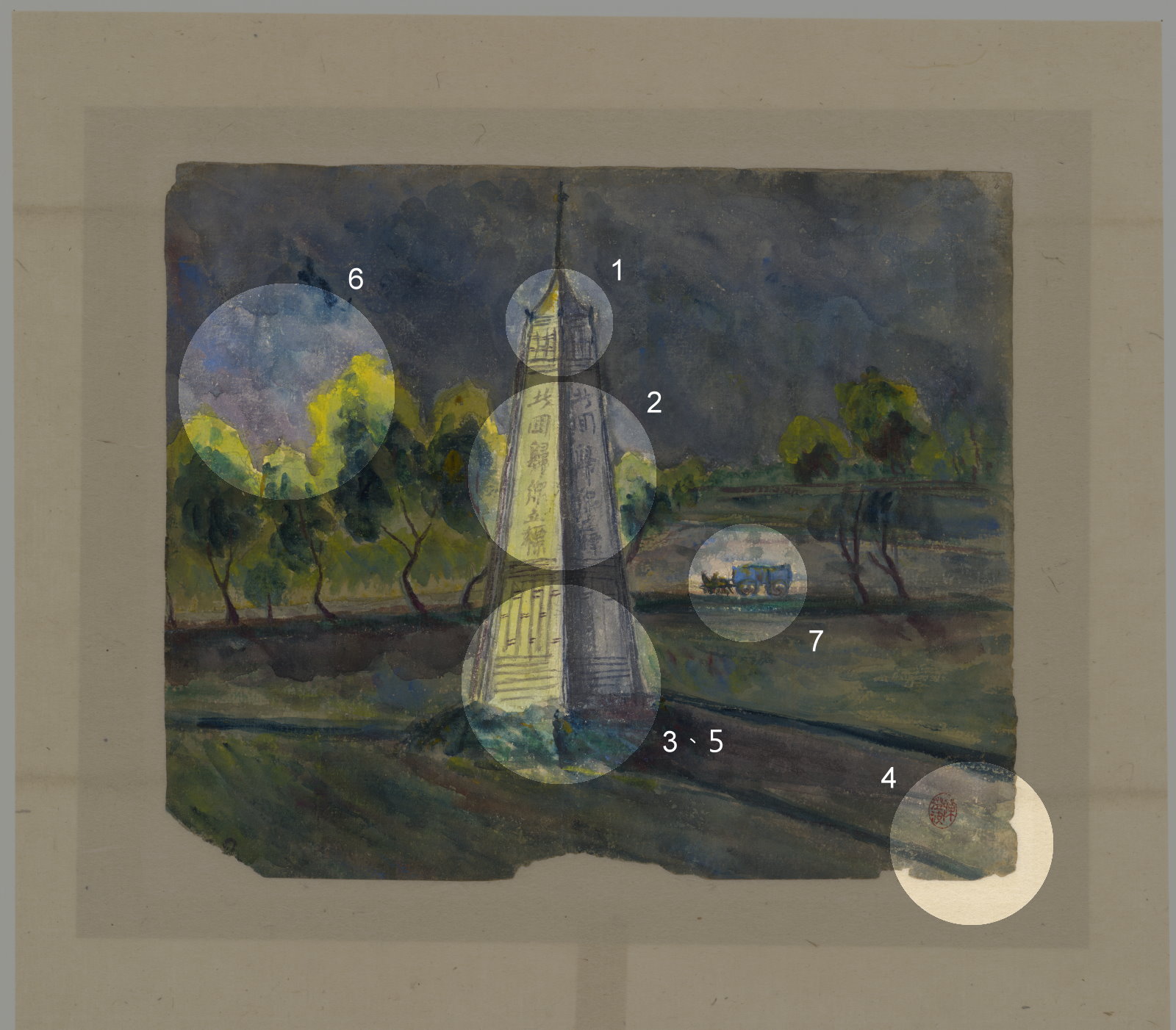
1.第二代北回歸線標誌1
The Second Tropic of Cancer Monument
二代目の北回帰線標塔
1908年,為慶祝縱貫鐵路全線通車,臺灣總督府選擇在鐵路與北迴歸線交界處附近設立紀念性的建物,此後成為嘉義的知名地標。第一代標誌後來因風災而損壞,遂於1915年改建為第二代標誌,亦即陳澄波畫中的方錐尖塔樣式。
In 1908, in celebration of the completion of the north-south rail line, the Taiwan Governor-General chose to erect a commemorative monument near the intersection of the rail line and the Tropic of Cancer. After this famous Chiayi landmark was severely damaged by a storm, a second monument was unveiled in 1915. It is this second monument which is portrayed in Chen Cheng-po’s painting.2
1908年、台湾総督府は縦貫線の全線開通を祝して、縦貫線と北回帰線が交わる付近に記念碑を建立しました。それ以降、この標塔は嘉義県内の名高いランドマークの一つとなりました。初代の標塔は風害により損壊してしまいましたが、1915年に建てられた二代目の標塔が、陳澄波の作品に描かれている方錐形の標塔です。
2.標誌立面上的文字
Inscriptions on the monument
標塔に刻された文字
北迴歸線標誌的立面寫著「北回歸線立標」。若對照文獻資料,立面文字應是「北回歸線標」,下方另有兩排小字標示其經緯度。在近代繪畫當中,每個畫家對於著重表現的細節都有不同考量,類似這樣的省略是很常見的情況。
The monument, as depicted in the painting, bears the inscription “Tropic of Cancer Post.” Yet, historical sources indicate that the actual inscription read “Tropic of Cancer Monument” and, underneath, a smaller inscription composed of two columns of Chinese characters indicated the latitude and longitude. Contemporary painters have their own rationale for including or omitting certain details, and as such, this sort of discrepancy (that is, Chen’s decision to not copy the inscription of the geographic coordinates) is a common occurrence.
この北回帰線標塔には「北回帰線立標」と記されています。文献資料によれば、標塔の文字は本来「北回帰線標」となり、その下には経緯度が2行に分けて小さな字で記されているはずです。近代絵画においては、各々の画家が重んじる表現の細部にはそれぞれ異なる考えがあり、このような省略がよく見られます。
1918年《臺灣拓殖畫帖》所附的第二代標誌照片,可以清楚見到標塔上的文字(包括經緯度的數目字「北緯二十三度二十七分四秒」、「東經百二十度二十四分四十六秒」)與細部構造。若比對陳澄波的作品,我們將會發現諸多細節的不同處,頗值得玩味。國立臺灣大學授權。
In these photographs of the second monument, taken from Paintings from the Colony of Taiwan (1918), the inscriptions (including the numbers denoting the latitude and longitude of the site, 23°27’4” N 120°24’46” E) are clearly visible, as are structural details of the monument. It is interesting to note that numerous details in Chen’s representation do not correspond to the actual monument as photographed.
1918年発行の『台湾拓殖画帖』に附された二代目標塔の写真では、標塔上の文字(経緯度の数値「北緯23度27分4秒」と「東経120度24分46秒」を含む)や細部の構造まではっきりと見て取れる。陳澄波の作品と比べると、細かな箇所にも多くの違いが見られ、非常に興味深い。
3.建立標塔的目的
Purpose of constructing the monument
標塔建立の目的
縱貫鐵路通車是一樁劃時代的重大工程,代表日本對於殖民地臺灣的建設成就。統治者選擇在北迴歸線上建立紀念標誌,藉由精確的經緯度測量彰顯其技術能力,也象徵著帝國實力的南向延伸,突破了地理學上的一個重要界限。
The completion of the north-south railroad was a feat of engineering that ushered in a new era and symbolized the success of Japanese efforts to modernize infrastructure in its colony of Taiwan. The decision to erect a commemorative monument along the Tropic of Cancer and the precision involved in measuring its latitude and longitude reflect the technical prowess of the empire and its capability to push southward, having already crossed one important geographical boundary.
当時、縦貫線の建設は世紀の大工事とされ、植民地台湾における建設工事の成果を代表するものでした。日本政府が北回帰線上に記念碑を建立することを選んだのは、経緯度測量の精確性によりその技術力を世界へ知らしめると共に、南方へと拡大し続ける日本帝国の実力が、地理学上重要とされる限界を突破したことの象徴でもありました。
4.陳澄波與水崛頭公學校
Chen Cheng-po and Shuikutou Public School
陳澄波と水崛頭公学校
1920年,原先在嘉義公學校任職的陳澄波轉調郊區的水崛頭公學校,北回歸線標誌便位在嘉義市與該校之間。換句話說,巨大的紀念標塔,是陳澄波往返兩地時必然會見到的景物。這幅畫的創作時間點,或許也就是在同一個時期。
In 1920, Chen was transferred in his capacity as instructor from Chiayi Public School to Shuikutou Public School, located on the city outskirts. As the Tropic of Cancer Monument stood between Chiayi City and Chen’s new place of work, he would inevitably catch sight of the giant commemorative structure each time he traveled between those two places. Thus, this painting was likely completed during this period of Chen’s life.
陳澄波は1920年に嘉義公学校から郊外の水崛頭公学校に転任しましたが、北回帰線標塔は嘉義市とその学校の間に位置します。つまり、この巨大な記念碑は、陳澄波が両地を行き来する際に必ず目にした景色の一つでした。この作品もその頃に制作されたものかもしれません。
5.陳澄波與「現代性」
Chen Cheng-po and modernity
陳澄波と「現代性(モダニティ)」
在日本時代的臺灣,機械、電氣、鐵橋……這類嶄新事物,正湧現於人們的生活周遭。這些象徵「現代性」的景物,一直是陳澄波在繪畫當中強調表現的重要元素。作為一種現代奇景,北回歸線標誌或也因此成為他的創作主題。
Machines, electricity, train trestles... Under Japanese rule, Taiwanese people witnessed brand-new innovations spring into their everyday surroundings. These sights of modernity are important recurrent elements in Chen’s paintings. It is perhaps for this very reason that the Tropic of Cancer Monument, a sort of modern marvel itself, became a subject of Chen’s work.
日本統治時代の台湾では、機械、電気、鉄橋など先進的な事物が人々の暮らしに次々と出現しました。これら「現代性(モダニティ)」を象徴するモチーフはずっと、陳澄波が用いた絵画表現を強調する大切な要素でした。一種の近代的な奇景である北回帰線標塔もまた、そうした理由で陳澄波の創作テーマの一つとなったのかもしれません。
6.水彩畫
Watercolor painting
水彩画
1913年,18歲的陳澄波進入臺北的總督府國語學校,並接受水彩畫家石川欽一郎的指導,正式開始學習西洋美術。從現存作品看來,他在這時期的創作以水彩畫為主,直到1924年赴日留學後,才逐漸在油畫的世界裡確立其藝術道路。
In 1913, eighteen-year-old Chen enrolled in the National Language [Japanese] School at the Taiwan Governor-General’s Office in Taipei. There, under the guidance of watercolorist Ishikawa Kinichiro, he commenced his formal training in Western art techniques. For the next decade, Chen was primarily focused on watercolor painting, as reflected by his surviving works from this period. It was not until after 1924 when he left to study abroad in Japan that he slowly began to establish himself as an oil painter.
1913年、18歳で台北の総督府国語学校に入学した陳澄波は、水彩画家の石川欽一郎より指導を受け、西洋美術を学び始めました。現存する作品を見ると、この時代は主に水彩画を描いていますが、1924年に日本へ留学して以降は、しだいに油彩画の世界で自らの道を確立していったのです。
7.輪車
Wheeled carts
牛車
以獸力拉動的輪車(通常是牛車)是舊時臺灣鄉村具有代表性的風景元素。交通建設逐漸發達的日治時期,牛車的功能也逐漸被機械車輛所取代。在這幅以現代化景物為主題的作品當中,以輪車為點綴,或也有製造對比的意圖。
In former times, cattle-drawn carts, usually ox-carts, were a characteristic feature of the rural Taiwanese landscape. As the Japanese colonizers worked to modernize Taiwan’s transportation systems, the ox-cart was gradually replaced by mechanized vehicles. Although Chen’s painting takes modern landscape as its central theme, the decorative flourish of the ox-cart perhaps reveals his desire to create a contrast between past and present.
家畜に牽引させる車(一般的には牛車)は、近代以前の台湾の農村を代表する風景の一つでしたが、交通インフラが発達した日本統治時代、牛車の役割もしだいに機械や車輌に取って代わられる事となりました。この近代的モチーフをテーマとした作品では、牛車をアクセントにすることで、両者の対比を作り出す意図があったのかもしれません。
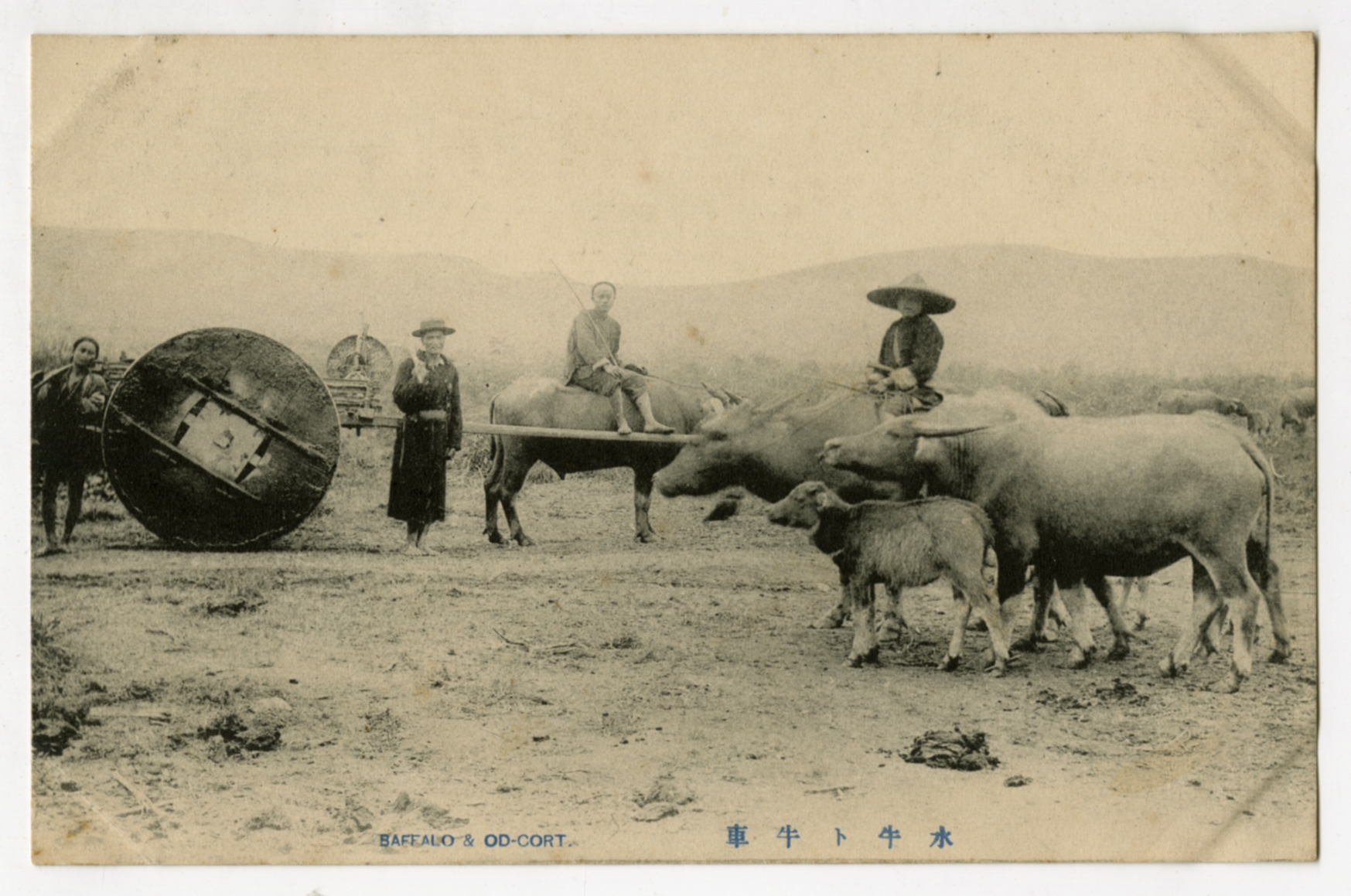
水牛ト牛車 BAFFALO & OX-CART, 臺大日治時期繪葉書, arrowntul-tw-1609621_2102_001
Baffalo (sic) & Ox-Cart, National Taiwan University Collection of Japanese Era Postcards, arrowntul-tw-1609621_2102_001
水牛ト牛車 台大日本統治時代絵葉書
1908, 臺灣總督府官房文書課編, 臺灣寫真帖, 頁93-94
日治時期,牛車作為臺灣的代表性景物,出現在總督府出版的《臺灣寫真帖》當中,成為獨立的小節。1935年,文學家呂赫若亦曾以〈牛車〉為主題,發表一篇左翼色彩濃厚的小說,刊載於日本的《文學評論》雜誌。這篇小說敘述的是一個駕駛牛車的底層勞動者,無法抵抗殖民政府帶到臺灣的機械化浪潮,其命運終致沉淪的故事。
1908, Collections of the Taiwan Governor-General Chief Cabinet Document Division, Photographs from Taiwan, p. 93-94.
During the Japanese colonial era, ox-carts were a typical feature of Taiwanese life, so much so that in Photographs from Taiwan, published by the Governor-General’s office, a separate section was devoted to the ox-cart. In 1935, a short story entitled “Ox-Cart,” penned by Taiwanese writer Lü He-ruo, appeared in the Japanese magazine Literary Review. Written in strident left-wing prose, “Ox-Cart” recounts the plight of a low-class laborer who, unable to withstand the wave of mechanization brought on to Taiwan by the colonial powers, loses his livelihood as an ox-cart driver and meets an unhappy, dishonorable end.
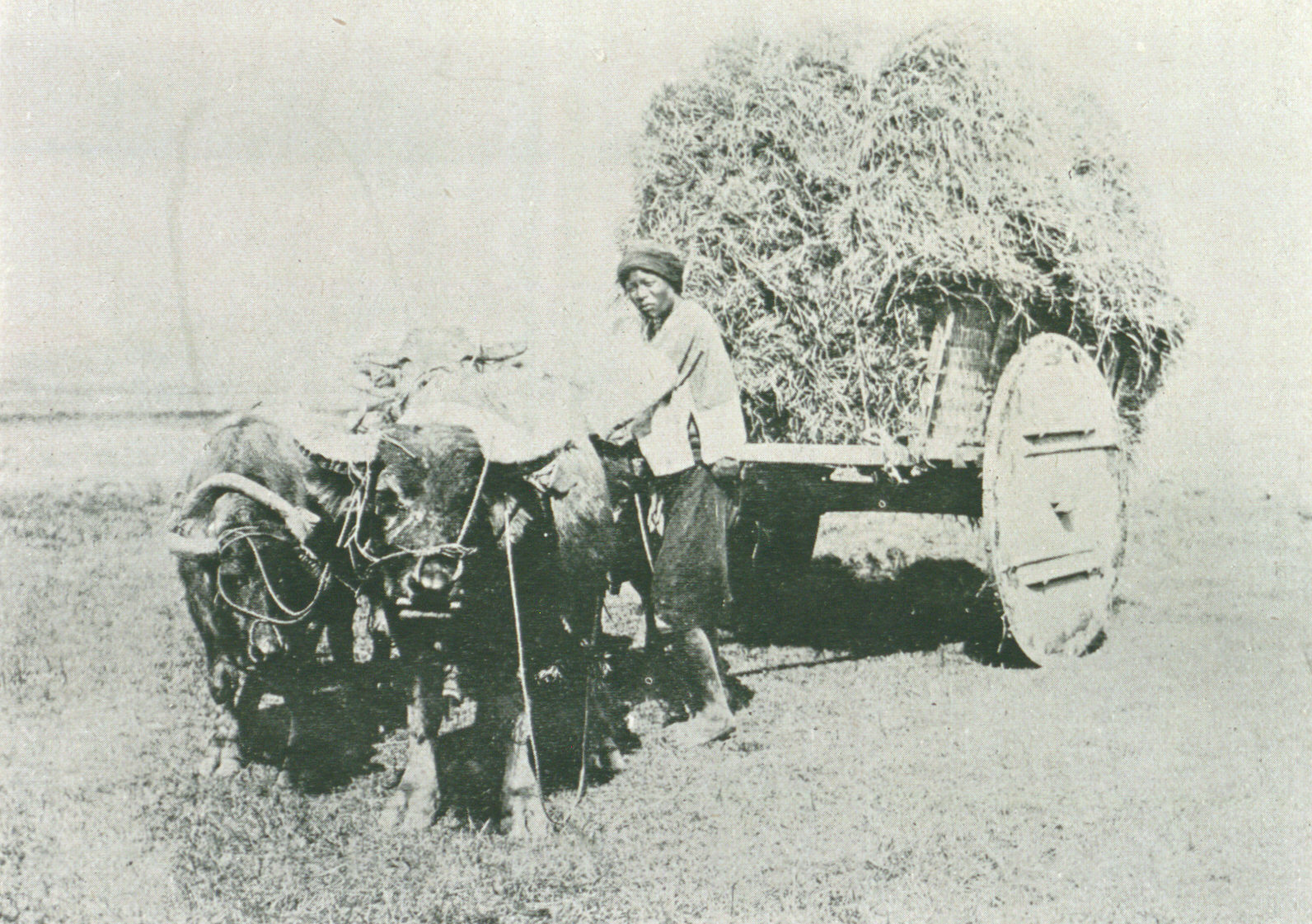
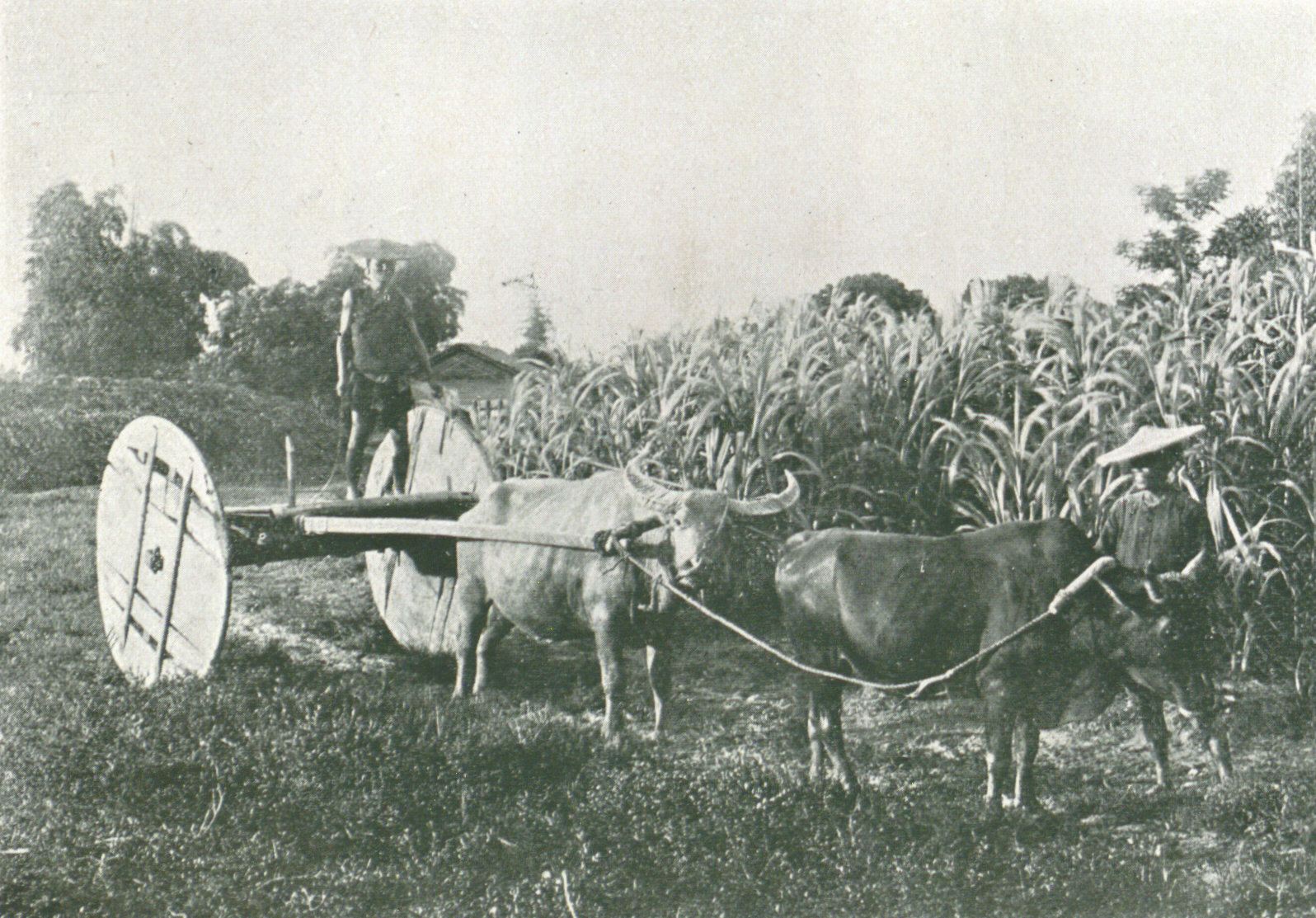
1908,台湾総督府官房文書課編,台湾写真帖,93-94頁。中央研究院臺灣史研究所檔案館授權。
日本統治時代の台湾を代表する風景の一つが牛車で、総督府により出版された『台湾写真帖』にも、牛車に関する一章が設けられている。小説家の呂赫若も1935年には、「牛車」をテーマとした左派的色合いの濃い小説を日本の雑誌『文学評論』に発表している。この小説では、日本政府により持ち込まれた機械化の波に逆らう術もなく凋落の一途をたどる、牛車を使う底辺の労働者たちの物語が描かれている。
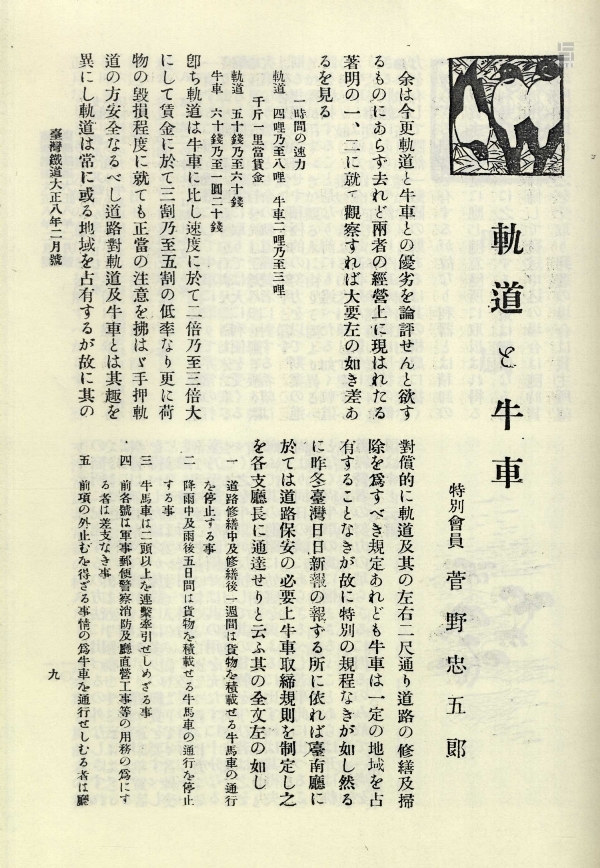
1919年一篇發表於《臺灣鐵道》期刊上的文章,題名為〈鐵道と牛車〉,剖析現代化交通建設與傳統臺灣牛車之間的競爭關係。國立臺灣圖書館授權。
Published in a 1919 issue of Taiwan Railway magazine, “Railway and Ox-cart” analyzes the competitive relationship between the traditional Taiwanese ox-cart and more modern means of transportation.
1919年、雑誌『台湾鉄道』にて発表された、「鉄道と牛車」と題された文章。近代的交通インフラの建設と台湾伝統の牛車との競合について分析している。
1杉山靖憲,《臺灣名勝舊蹟誌》(1916);《臺灣拓殖畫帖》(1918)。
Sugiyama Yasunori, Famous Sights of Taiwan (1916); Paintings from the Colony of Taiwan (1918)
杉山靖憲,『台湾名称旧跡誌』(1916);『台湾拓殖画帖』(1918)。
